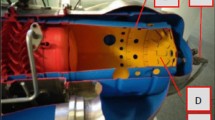Abstract
This paper first describes the existing and the anticipated requirements to be met by commercial aircraft engines and discusses them with a view to the development work and measures considered necessary to effectively protect the earth’s atmosphere.
Then the present level of pollutant emissions attained with today’s engines is explained taking the CF6–50C engine as an example. Furthermore this paper outlines the development potential of future engines for subsonic commercial aircraft with respect to a reduction of the specific fuel consumption and the specific pollutant emission. In this connexion, possible future emission levels attainable with kerosine, methane and hydrogen are compared.
The reduction of specific fuel consumption and specific pollutant emission achievable with the aid of new technologies are set against the expected development in air traffic and the resulting tendency towards an increase in the fuel consumption by commercial aircraft worldwide. This comparison shows that a perceptible lessening of the impact on the atmosphere in and above the tropopause is possible only in the long run provided the specific fuel consumption as well as the specific pollutant emissions of engines can be drastically reduced.
Access this chapter
Tax calculation will be finalised at checkout
Purchases are for personal use only
Preview
Unable to display preview. Download preview PDF.
Similar content being viewed by others
References
Grieb H., Eckardt D.: Propfan and Turbofan — Antagonism or Synthesis ICAS Congress, 1986, London
Pellischek G.: Compact High-Performance Heat Exchangers for ICR Aircraft Gas Turbines European Propulsion Forum, 1990, Cologne
Spadaccini L.J., TeVelde J.A.: Autoignition Characteristics of Aircraft-Type Fuels Combustion and Flame 46: 283–300 (1982)
Ekstedt, E.E.: Advanced Low Emissions Combustor Program AIAA-87–2035
Sokolgwski D.E., Rohde J.E.: The E3 Combustors: Status and Challenges NASA TM 82684 (1981)
Anderson, D.N.: Emissions of Oxides of Nitrogen from an Experimental Premixed Hydrogen Burner NASA TM X-3393, 1976
Sosounov, V. Some Aspects of Hydrogen and Other Alternative Fuels for Application in Air-Breathing Engines ISOABE, IX International Symposium on Air-Breathing Engines, 1989, Athens
Author information
Authors and Affiliations
Editor information
Editors and Affiliations
Rights and permissions
Copyright information
© 1990 Springer-Verlag Berlin Heidelberg
About this paper
Cite this paper
Grieb, H., Simon, B. (1990). Pollutant Emissions of Existing and Future Engines for Commercial Aircraft. In: Schumann, U. (eds) Air Traffic and the Environment — Background, Tendencies and Potential Global Atmospheric Effects. Lecture Notes in Engineering, vol 60. Springer, Berlin, Heidelberg. https://doi.org/10.1007/978-3-642-51686-3_4
Download citation
DOI: https://doi.org/10.1007/978-3-642-51686-3_4
Publisher Name: Springer, Berlin, Heidelberg
Print ISBN: 978-3-540-53352-8
Online ISBN: 978-3-642-51686-3
eBook Packages: Springer Book Archive




